|
Roseate Tern Sterna dougallii Charrán Rosado, |
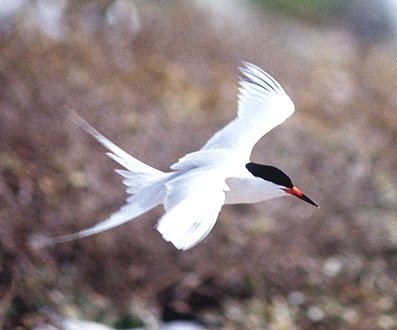 |
|
Photo: J. Saliva
|
|
Roseate Tern Sterna dougallii Charrán Rosado, |
 |
|
Photo: J. Saliva
|
|
IDENTIFICATION: A white tern with very light upper parts (appearing almost white), a very long, forked tail and bright orange legs. It has a thin, black bill, with the basal half turning orange at the beginning of the breeding season. In breeding plumage, it has a black cap and may have a pink tinge to the undersides. When not breeding, the forehead is white. Length: 33-41 cm., including long tail feathers; average weight: 100 g. for Caribbean breeders, 112 g. for migrant birds from northeastern USA. VOICE: A harsh, two-note alarm call, described as "cack, cack." Audio (M. Oberle). HABITAT: Feeds in bays and close to shore in the breeding season, but disperses to open seas after breeding on isolated islands. HABITS: The Roseate Tern feeds over shallow reefs and sandy shoals. It also follows schools of predatory fish and then plunges up to 50 cm. into the ocean to capture small fish that have been forced to the surface by the predators. It sometimes forages with Sandwich Terns or Brown Noddies, and occasionally steals fish from Brown Pelicans. Preferred fish in Puerto Rico include anchovies (Anchoa sp.), reef silverside (Hypoatherina harringtonenesis) and Dwarf herring (Jenkinsia lamprotaenia). The courtship display may involve several birds in a graceful aerial chase. In April and May, the male and female scrape a simple nest in beach sand or coral rubble, often in mixed colonies with other tern species, but in Culebra the Roseate Tern nests between boulders on steep cliffs. Both sexes incubate the clutch of 1-3 eggs for 22-24 days. The adults often forage within two kilometers of the colony and feed the young for about eight weeks---long after the young fledge at 22-30 days. After breeding, this species disperses to sea, staging as far as the north coast of Brazil. STATUS AND CONSERVATION: The Roseate Tern population in Puerto Rico is listed as a threatened species by the federal government, and the nesting population in New York and New England is listed as endangered. It is a local breeder on offshore islands near Puerto Rico, but is rare from October to April. Some birds seen in Puerto Rican waters breed in North America. Banding recoveries have documented that Roseate Terns from Maine, Connecticut, New York and Massachusetts migrate to Puerto Rico. The population of this species had declined due to egg collecting for markets, nest predation by gulls, and feather collecting for women’s clothing a century ago. Nest predation is especially serious for the migrant population that nests off New England and migrates to the Caribbean. Several gull species have flourished there due to human garbage and fishing activities. Roseate Terns have recently returned to nest at 11 islands off New England, after predatory gulls had been removed. In Puerto Rico, land crabs (Gecarcinus, Coenobita), Sally Lightfoot crabs (Grapsus grapsus), Frigatebirds, and Laughing Gulls threaten chicks. The entire world breeding population is estimated to be only 40,000 pairs, with at most 4,000-6,000 in the West Indies. RANGE: The Roseate Tern has a scattered breeding distribution: from tropical seas of the Caribbean, Indian Ocean, and southwest Pacific, to cold waters off the British Isles, New England, and Nova Scotia. Regular places to see Roseate Tern in the breeding season are off Culebra and near the small, treeless coral islets south of La Parguera. TAXONOMY: CHARADRIIFORMES; LARIDAE; Sterninae |
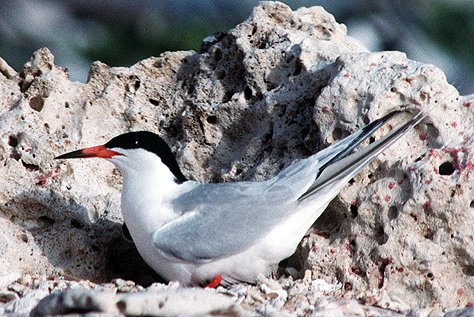 |
|
Photo: J. Saliva
|
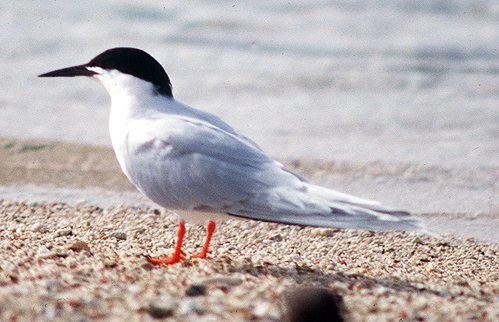 |
|
Photo: J. Saliva
|
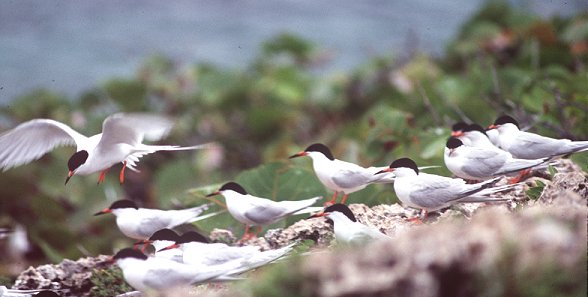 |
|
Photo: J. Saliva
|
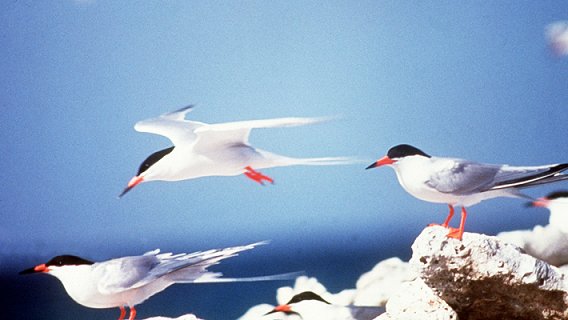 |
|
Photo: J. Saliva
|
|
References Bent, A.C. 1921. Life histories of North American gulls and terns. Smithsonian Instit. U.S. National Museum Bull. 113. (Reprinted by Dover Press, 1963). Burger, A. E. and A. D. Lawrence. 2000. Seabird monitoring techniques. Pp. 148-173 in Status and conservation of West Indian seabirds (E. A. Schreiber and D. S. Lee, eds.). Soc. Carib. Ornith., Special Pub. No. 1. Burger, J., and M. Gochfield. 1991. Lead, mercury and cadmium in feathers of tropical terns in Puerto Rico and Australia. Arch. Env. Contamination and Toxicology 21:311-315. del Hoyo, J., A. Elliott, and J. Sargatal, eds. 1996. Handbook of Birds of the World, Vol. 3. Hoatzin to Auks. Lynx Edicions, Barcelona. Ehrlich, P.R., D.S. Dobkin, and D. Wheye. 1988. The birder’s handbook: a field guide to the natural history of North American birds. Simon and Schuster/Fireside, NY. Gochfeld, M., J. Burger, and I.C.T. Nisbet. 1998. Roseate Tern (Sterna dougallii). No. 370 in The birds of North America (A. Poole and F. Gill, eds.). The Birds of North America, Inc., Philadelphia, PA. Harrison, P. 1983. Seabirds: an identification guide. Houghton Mifflin, Boston. Harrison, P. 1987. A field guide to seabirds of the world. Stephen Greene Press, Lexington, MA. Hume, R.A. 1993. Common, Arctic, and Roseate Terns: an identification review. Brit. Birds. 86:210-217. Raffaele, H.A. 1989. A guide to the birds of Puerto Rico and the Virgin Islands. Princeton. Raffaele, H.A. 1989. Una guía a las aves de Puerto Rico y las Islas Vírgenes. Publishing Resources, Inc., Santurce, PR. Raffaele, H.A., J.W. Wiley, O.H. Garrido, A.R. Keith, and J.I. Raffaele. 1998. Guide to the birds of the West Indies. Princeton. Saliva. J. E. 2000. Status and conservation of Roseate Terns in the West Indies. Pp. 87-95 in Status and conservation of West Indian seabirds (E. A. Schreiber and D. S. Lee, eds.). Soc. Carib. Ornith., Special Pub. No. 1. Schreiber, E. A. and D. S. Lee. 2000. West Indian seabirds: a disappearing natural resource. Pp. 1-10 in Status and conservation of West Indian seabirds (E. A. Schreiber and D. S. Lee, eds.). Soc. Carib. Ornith., Special Pub. No. 1. Schreiber, E. A. 2000. Action plan for conservation of West Indian seabirds. Pp. 182-191 in Status and conservation of West Indian seabirds (E. A. Schreiber and D. S. Lee, eds.). Soc. Carib. Ornith., Special Pub. No. 1. Shealer, D.A. 1998. Size-selective predation by a specialist forager, the Roseate Tern. The Auk. 115(2):519-525. Shealer, D. A. 1998. Differences in diet and chick provisioning between adult roseate and sandwich terns in Puerto Rico. Condor 100(1):131-140. Shealer, D. A. and J. Burger. 1993. Effects of interference competition on the foraging activities of tropical Roseate Terns. Condor 95:322-329. Wiley, J. W. 2000. A bibliography of seabirds in the West Indies. Pp. 192-225 in Status and conservation of West Indian seabirds (E. A. Schreiber and D. S. Lee, eds.). Soc. Carib. Ornith., Special Pub. No. 1. Next related species in taxonomic order Previous related species in taxonomic order |